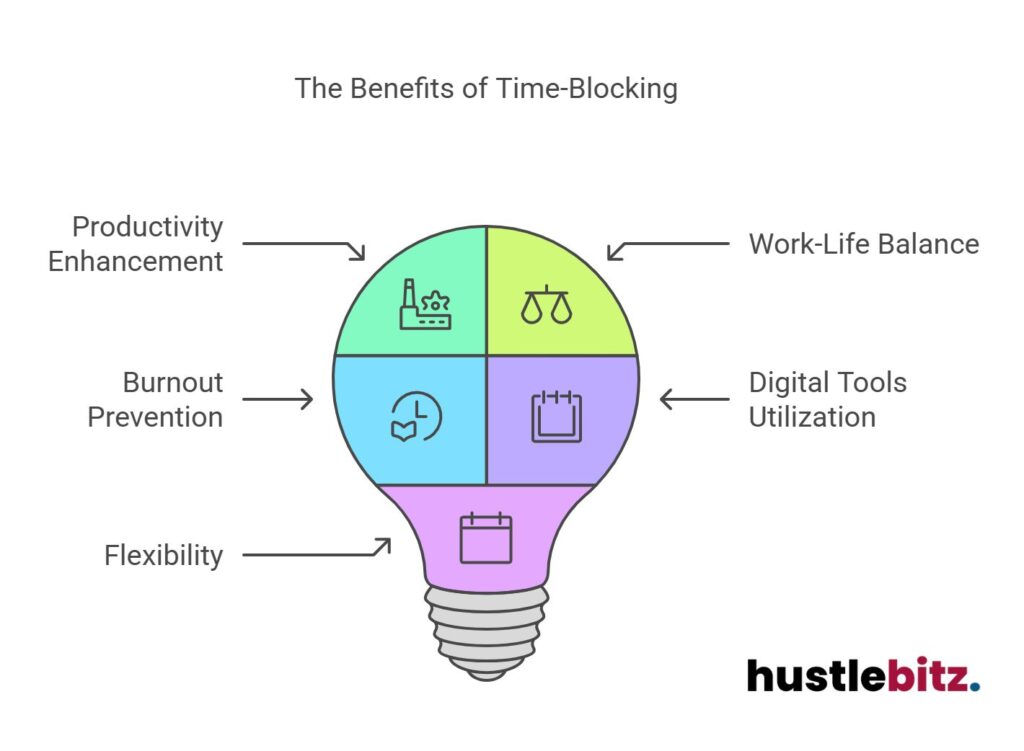Time-blocking is a highly effective productivity method that structures your day into designated time segments for specific tasks. This approach promotes enhanced focus and efficiency by encouraging task prioritization aligned with your goals. It also helps manage energy levels, allowing for regular breaks to sustain performance. By providing a clear roadmap of responsibilities, time-blocking reduces stress and enhances work-life balance. Ultimately, it creates an organized framework for achieving deeper engagement with tasks. Exploring more about this technique can unveil additional strategies for implementation and overcoming common challenges.
Key Takeaways
- Time-blocking enhances productivity by allocating specific time slots for focused work, reducing distractions and procrastination.
- It promotes work-life balance by clearly delineating work hours from personal time, ensuring both areas receive attention.
- Regular breaks are incorporated within time blocks to prevent burnout and sustain energy levels throughout the day.
- Utilizing digital calendars and task management tools aids in visual planning and tracking progress effectively.
- Flexibility in adjusting time blocks allows for adaptability to unexpected challenges and shifting priorities.

What Is Time-Blocking?
Time-blocking is a productivity technique that involves scheduling specific blocks of time for distinct tasks or activities, thereby enhancing focus and efficiency in completing work. This method encourages individuals to allocate dedicated periods for various responsibilities, which can lead to improved mental clarity and effective time management. By integrating time blocking techniques into daily scheduling, individuals can better prioritize tasks and minimize distractions, enabling them to tackle their responsibilities with greater focus.
One of the core principles of time-blocking is task prioritization. This involves identifying the most critical tasks aligned with personal or professional goals. By establishing a clear framework through goal setting, individuals can ensure that their time is spent effectively, facilitating work-life balance. Moreover, this approach serves as a powerful procrastination solution, as it provides a structured environment that discourages the tendency to delay important tasks.
Focus strategies are integral to the success of time-blocking. By committing to specific time slots for concentrated work, individuals can cultivate a sense of urgency and motivation, ultimately enhancing productivity. Furthermore, the practice of time blocking encourages regular breaks, which contribute to sustained energy levels throughout the day.
Benefits of Time-Blocking

Implementing time-blocking can significantly enhance productivity by providing a structured framework that fosters focus and minimizes distractions. One of the primary benefits of this method is the productivity boost it offers, allowing individuals to accomplish more in less time. By allocating specific time slots for tasks, users experience focus enhancement, which leads to deeper engagement with their work.
Additionally, time-blocking facilitates stress reduction by creating a clear roadmap of responsibilities. This clarity allows for effective task prioritization, ensuring that high-impact activities receive the attention they deserve. Furthermore, it promotes efficient energy management; individuals can schedule demanding tasks during their peak energy hours, thereby maximizing output.
Incorporating time-blocking into daily routines also supports work-life balance. By delineating work hours and personal time, individuals can better align their goals with their overall life objectives. This goal alignment fosters a sense of purpose, motivating users to adhere to their planned schedules.
Moreover, having an accountability partner can enhance the effectiveness of time-blocking. Regular check-ins with a colleague or friend can provide motivation and reinforce commitment to the established time blocks.
Lastly, time-blocking encourages creative thinking by allocating time for brainstorming and reflection. When individuals are not rushed, they can explore innovative ideas and solutions.
How to Get Started

To embark on a successful time-blocking journey, begin by assessing your current schedule and identifying tasks that require focused attention. This initial step involves setting priorities, as not all tasks hold equal significance. Create a comprehensive list of your responsibilities, distinguishing between urgent and important tasks to ensure you allocate your time effectively.
Next, estimate the duration required for each task. Understanding how long tasks typically take will help you visualize blocks of time needed on your calendar. While scheduling these blocks, incorporate breaks to recharge your mind; this promotes sustained focus and prevents burnout.
Maintaining flexibility is crucial in time-blocking. Life can often be unpredictable, so be prepared to adapt your plans as necessary. As you implement your time-blocking strategy, consistently track progress. This will not only help in evaluating your efficiency but also serve as a motivational tool when you see tangible accomplishments.
Visualizing blocks in your planner can aid in maintaining clarity on your daily objectives. At the end of each week or month, take the time to review the effectiveness of your time-blocking approach. Reflect on what worked, what didn’t, and how you might adapt techniques to better suit your evolving needs.
Finding motivation is essential, so celebrate small victories along the way. By fostering a proactive mindset and continuously refining your approach, you can maximize your focus and output through the power of time-blocking.
Tools for Effective Time-Blocking

Utilizing the right tools can significantly enhance the effectiveness of your time-blocking strategy, ensuring that you stay organized and focused on your priorities. In today’s digital age, various productivity software and time-blocking apps are available, each equipped with features designed to streamline your workflow.
To optimize your time-blocking efforts, consider incorporating the following tools:
- Digital Calendars: Leverage calendar integration in platforms like Google Calendar or Outlook. These tools allow you to visually plan your day and allocate specific blocks for tasks, meetings, and breaks, enhancing your overall time management.
- Task Management Software: Tools such as Trello or Asana provide effective task management capabilities. They enable you to break down projects into manageable tasks, assign deadlines, and track progress, facilitating better focus techniques.
- Time Tracking Tools: Applications like Toggl or Clockify help monitor how much time you spend on various activities. This insight allows for adjustments in your time-blocking strategy, ensuring that you remain productive and aligned with your goals.
- Collaboration Platforms: For team-oriented tasks, consider using collaboration platforms like Slack or Microsoft Teams. Their automation features can facilitate communication and streamline project management, allowing for easier coordination during focused work sessions.
Incorporating these tools into your time-blocking routine will not only enhance productivity but also make the process of visual planning more effective and engaging.
Creating Your Time Blocks

Establishing effective time blocks requires a thoughtful approach to prioritizing tasks and allocating dedicated periods for focused work. To begin, consider employing time block techniques that align with your unique workflow. Start by identifying your most pressing tasks and applying prioritization strategies to determine which require immediate attention and which can be scheduled later.
Daily scheduling tips can be invaluable in crafting a routine that enhances productivity. For instance, allocate specific time slots for high-priority tasks, ensuring effective time allocation that minimizes distractions. This may involve setting boundaries around your workspace or communicating your availability to colleagues, thereby fostering an environment conducive to focus.
Visual planning methods, such as color-coded calendars or digital scheduling tools, can assist in clearly delineating different time blocks. This visual representation not only aids in organization but also serves as a reminder of your goals for the day.
Moreover, integrating breaks within your time blocks is crucial for maintaining sustained productivity. Short breaks allow for mental rejuvenation, enabling you to return to your tasks with renewed focus.
Regularly evaluating productivity is necessary to refine your time-blocking approach. As you adapt routines based on what works best for you, remain open to adjusting your blocks as needed to optimize your workflow.
Overcoming Common Challenges
Overcoming common challenges in time-blocking requires a proactive mindset and strategic adjustments to ensure sustained focus and productivity. As individuals navigate their schedules, they may encounter distractions that hinder their effectiveness. Implementing targeted strategies can significantly enhance the time-blocking experience.
- Procrastination Strategies: Identify triggers that lead to procrastination and employ techniques such as the Pomodoro Technique, which promotes focused work followed by brief breaks to maintain motivation and sustain energy.
- Distractions Management: Limit interruptions by creating a dedicated workspace and utilizing apps designed to block distracting websites. This fosters a controlled environment conducive to concentration.
- Prioritization Techniques: Utilize methods such as the Eisenhower Matrix to categorize tasks based on urgency and importance, ensuring that high-priority activities receive adequate attention during designated time blocks.
- Flexibility Approaches: Embrace the need for routine adjustments, recognizing that unexpected challenges may arise. Maintaining flexibility allows for seamless adaptation while minimizing stress.
Incorporating technology integration can further streamline the time-blocking process, enhancing organization and focus. Additionally, employing visualization methods can clarify goals, thereby boosting motivation.
Engaging with accountability partners can provide necessary encouragement and support, reinforcing commitment to time-blocking practices.
Time-Blocking for Different Roles

Time-blocking can be tailored to meet the unique demands of various roles, enhancing productivity and focus across different professional landscapes. By implementing structured time blocks, individuals can allocate specific periods for tasks aligned with their responsibilities, ultimately improving efficiency.
| Role | Time-Blocking Strategy |
| Executives | Allocate blocks for strategic planning and decision-making. |
| Students | Schedule study sessions and breaks to optimize learning. |
| Freelancers | Designate time for client work, networking, and skill development. |
| Parents | Create blocks for family time, chores, and personal care. |
| Remote Workers | Set clear boundaries between work hours and personal time. |
| Teachers | Plan lessons and grading periods to streamline workload. |
| Managers | Use blocks for team meetings and project oversight. |
| Salespeople | Schedule client outreach and follow-up calls efficiently. |
| Creatives | Allocate uninterrupted time for brainstorming and creation. |
| Engineers | Designate time for coding, testing, and project management. |
Each of these roles benefits from a customized approach to time blocking. For example, time blocking for executives allows them to carve out essential thinking time, while time blocking for students promotes focused study habits. Similarly, freelancers can manage varying client demands by using dedicated blocks, whereas parents can balance family responsibilities more effectively. Overall, adopting time-blocking strategies tailored to specific roles can significantly enhance productivity and focus, making it a versatile tool in today’s diverse work environments.
Adjusting Your Blocks

Effectively managing your time blocks involves regularly assessing and adjusting them to align with changing priorities and demands in your professional and personal life. This dynamic approach ensures that you remain focused and productive, even as tasks and deadlines evolve.
To optimize productivity and adapt your routines, consider the following strategies:
- Assessing Progress: Regularly evaluate the effectiveness of your time blocks. Are you meeting your personal deadlines? If not, identify the underlying issues and make necessary adjustments to your schedule.
- Adjusting Priorities: Life is unpredictable, and priorities can shift rapidly. Be prepared to reorganize your blocks to reflect these changes, ensuring that urgent tasks receive the attention they require.
- Flexible Scheduling: Implement flexible scheduling techniques that allow you to respond to interruptions and distractions more effectively. This might involve allocating buffer time between blocks to account for unexpected issues.
- Incorporating Mindfulness Techniques: Utilize mindfulness practices to enhance your focus during designated work times. By minimizing distractions and managing interruptions, you can create a more conducive environment for achieving your goals.
Final Thoughts
Time-blocking is a transformative productivity technique that, when implemented thoughtfully, can significantly improve focus and output. By organizing your day into dedicated blocks of time for specific tasks, you can reduce distractions, manage your energy effectively, and maintain a healthy work-life balance. The key to successful time-blocking lies in regular assessment and adjustment of your blocks to align with changing priorities and demands. By incorporating tools, flexibility, and mindfulness into your approach, you can create a structured yet adaptable framework that empowers you to achieve your goals efficiently. Embrace time-blocking as a powerful strategy to enhance your productivity and lead a more organized, fulfilling life.




